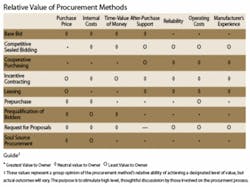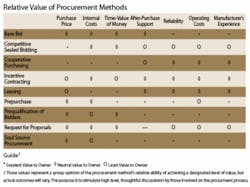by Dave Doin
Let’s face it, not all suppliers were created equal. Some offer better products, or better service, or both. In the water and wastewater industry numerous infrastructure projects are bid and awarded each year based on initial purchase price, with little to no consideration for supplier support, warranty, product quality/reliability, compliance with bid specifications, and true cost, which includes life-cycle, or whole-of-life costs.
This frequently happens where public financing is involved and a common procurement method is used that does not take into consideration the true scope of supply required to make the project successful over the many years of its expected life.
Sure, specifications are developed in an effort to establish minimum requirements but, in the absence of an appropriate procurement method, they frequently become so broad that their usefulness becomes questionable. Moreover, the specifications too often focus on the hardware, without proper regard for the supplier’s track record, reliability of the equipment, operating costs, or after-purchase support from the supplier. As an important part of a community’s infrastructure, such equipment is expected to provide 20, 30, 40+ years of satisfactory operation. Certainly then, the value proposition of any supplier must include much more than initial purchase price.
Many larger municipalities recognize that initial price should not be the sole or principal determinant in choosing the equipment that will serve their communities for the next several decades and often avoid using public funding due to the red-tape involved and the restrictions placed on choosing the appropriate supplier. On the other hand, smaller communities rely on public funding to finance a large portion of the infrastructure development work they undertake. To insure that they get the best value on bid day, these communities need to minimize their risk and maximize the value they receive by employing the appropriate procurement method.
Procurement methods range from sealed, competitive bids to sole source procurement where the value to the owner ranges from low to high when considering elements of value besides initial purchase price. The sealed, competitive bid provides the lowest value to the owner, yet it is a common method and the one most likely to produce poor results. The sole source procurement method provides the greatest value to the owner. Yet, there are concerns over the competitiveness of a supplier who is sole-sourced and, while not impossible to get approved, funding agencies tend to frown upon this procurement method. There are other procurement methods that can provide the appropriate equipment at a competitive price.
The table with this article is from a joint paper by WWEMA and AMSA (Now NACWA, National Association of Clean Water Agencies) entitled “Optimizing Public Agency Purchasing Power”. This table outlines the different major procurement methods and the relative value to the owner associated with each method based on various elements of value.
The sole-source procurement method provides the greatest value to the owner. Yet, there are other procurements methods that can be employed that are quite effective at maximizing value to the owner. One such method is to pre-qualify bidders to screen out the poor ones and to evaluate others on their ability to provide the full scope of supply necessary for the success of the project.
Another procurement method that works quite well to maximize owner value while providing necessary consideration to initial purchase price is the evaluated bid (pre-purchase base bid in the table). In the pre-purchase base bid, specific suppliers are named and alternatives are not considered unless provided specifically for in the bid form. Under this model, equipment is selected based on factors such as cost analysis, value analysis, or other factors other than initial purchase price. A variation of this method involves specifying the elements of value for a particular project and associating a weighting representing the relative importance of each. In such a case, initial purchase price is typically listed as an element of value, but it is not the sole determinant. Initial purchase price may carry a weighting of 25% in evaluating the total offering, while other elements of value, such as the suppliers’ experience and ability to successfully execute the contract, equipment O&M requirements, life cycle costs, etc. are listed and assigned a relative weighting. It is not necessary to pre-approve bidders under this method as bids are evaluated against the suppliers’ ability to score high against the weighted elements of value.
Frequently on bid day the temptation to take the lowest price is often too great. When the proper procurement method was not used, there is little ammunition for the engineer to fight the funding agency when the funding agency wants to approve the lowest bidder. The stage was set early on when “or equal” was added to the specifications; or when the effort to specify exactly what was needed was thwarted because the funding agency insisted that an alternative manufacturer be named in the specifications.
Employing the appropriate procurement method may not be the easiest or simplest approach as it may require additional steps in the process, a more detailed evaluation of suppliers, and, very possibly, extra effort to get the funding agency on board. Yet, taking the time and making the extra effort could mean the difference between procuring cheap, unreliable equipment with high O&M costs and procuring quality, proven equipment with a lower overall (whole of life) cost.
About the author:
Dave Doin is Vice President of Sales at Environment One Corporation, a manufacturer of products and services for the disposal of residential sanitary waste, based in Niskayuna, New York. He is also Treasurer of WWEMA and serves on its Board of Directors.




